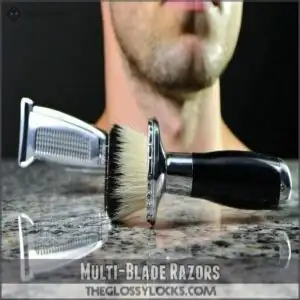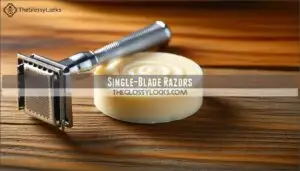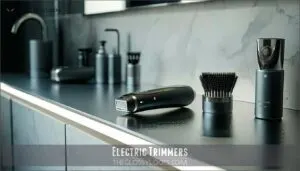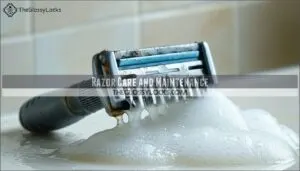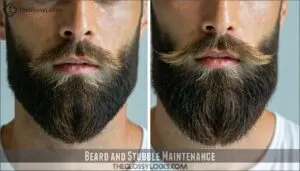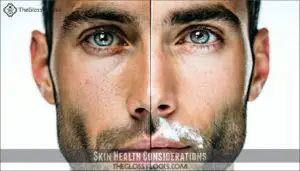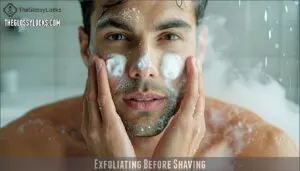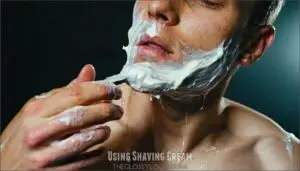This site is supported by our readers. We may earn a commission, at no cost to you, if you purchase through links.
 For ideal smoothness, you’ll need to shave your face every 1-3 days, depending on your hair growth rate.
For ideal smoothness, you’ll need to shave your face every 1-3 days, depending on your hair growth rate.
Fast growers might need daily shaving, while slower growth patterns allow for every other day or twice weekly.
To determine how often to shave face for smooth results, pay attention to your stubble’s reappearance—when you feel that slight sandpaper sensation, it’s time.
Using quality razors with sharp blades substantially improves results, as does proper preparation with warm water and shaving cream.
Remember, finding your perfect shaving frequency isn’t just about smoothness—it’s about balancing skin health with your desired appearance.
The right technique matters even more than frequency.
Table Of Contents
- Key Takeaways
- Shaving Frequency Matters
- How Often Shave Face Smooth
- Choosing Right Razor Type
- Razor Care and Maintenance
- Beard and Stubble Maintenance
- Skin Health Considerations
- Shaving Techniques for Smooth Skin
- Minimizing Shaving Complications
- Frequently Asked Questions (FAQs)
- How often should I shave to keep a smooth face?
- Does shaving face make skin smoother?
- Does shaving affect facial hair growth speed?
- Can weather conditions influence shaving frequency?
- How does diet impact facial hair growth?
- Should shaving frequency change with age?
- Are pre-shave oils worth the investment?
- How does water temperature affect shaving results?
- Best time of day to shave?
- How do seasons affect facial hair growth?
- Conclusion
Key Takeaways
- Shave every 1-3 days depending on your hair growth rate; daily for fast growers, every other day or twice weekly for slower growth.
- Use a sharp razor, shave with the grain, and prepare your skin with warm water and shaving cream for smooth results with less irritation.
- Sensitive skin? Shave every 3-4 days, use fragrance-free shaving cream, and apply alcohol-free aftershave to keep skin calm and healthy.
- Regular razor care, like rinsing after use and replacing blades every 5-7 uses, ensures clean shaves and prevents irritation or razor bumps.
Shaving Frequency Matters
You’ll need to find the right shaving frequency for your skin type and hair growth pattern, as this directly impacts both skin health and facial appearance.
Finding your ideal schedule, whether it’s daily, every few days, or weekly, will help you maintain a consistently smooth face while minimizing irritation and ingrown hairs.
Daily Shaving Routine
A daily shaving routine throughout the week provides the cleanest, most professional appearance.
For smooth results, your Morning Prep must include:
- Cleanse with warm water to open pores and soften facial hair
- Apply quality shaving cream suited to your skin type
- Verify Razor Sharpness by using a clean, well-maintained blade
- Shave with Consistent Technique, following hair growth direction
- Finish with proper Skin Hydration using an Aftershave Balm
This shaving frequency offers excellent exfoliation benefits, but requires commitment to prevent irritation. Daily shaving demands attention to detail for maintaining a perfectly smooth face.
Shaving Every Other Day
Moving from daily razor routines, shaving every other day presents an ideal middle ground for many men.
This shaving frequency allows proper skin recovery while maintaining a professional appearance.
Your face gets valuable healing time between sessions, which substantially reduces irritation and product buildup.
With this schedule, you’ll notice smoother results as hair regrowth reaches the perfect length for cutting.
It’s particularly effective for medium-thick facial hair types, offering the perfect balance between a clean-shaven look and the time investment required for daily shaving tips.
This shaving frequency is beneficial because it allows for proper skin recovery and is time efficient, making it suitable for various individuals, including those with sensitive skin.
Weekly Shaving Schedule
While those on an every-other-day rhythm need frequent touch-ups, a weekly shaving schedule offers a more relaxed grooming approach.
This routine works perfectly if you have sparse hair or thin facial features that don’t demand constant attention.
Your skin gets valuable recovery time between sessions, reducing irritation risks.
Many men with slower growth patterns naturally align with a 7-day cycle, finding it strikes the ideal balance between smooth skin and minimal trimming needs, allowing for minimal trimming needs, and weekly beard shaping maintains just enough stubble without constant maintenance.
How Often Shave Face Smooth
The pursuit of smooth skin requires finding your personal shaving frequency sweet spot.
For most men, a 2-3 day interval between shaves provides ideal skin health while maintaining a professional appearance.
Your shaving habits should be guided by:
- Skin type impact: sensitive skin benefits from 3-4 day intervals
- Hair growth factors: genetic variations influence regrowth speed
- Professional appearance requirements: balance workplace expectations with skin needs
While daily shaving exfoliates by removing dead cells, dermatologists caution against this practice as it compromises your skin’s protective barrier.
Using sharp blades can help reduce skin irritation.
Listen to your skin’s signals—redness or irritation indicates you need more recovery time between sessions for proper healing and lifestyle integration.
Choosing Right Razor Type
Your choice of razor substantially impacts your shaving experience, affecting both comfort and results based on your facial hair type and shaving frequency.
You’ll need to think about whether a multi-blade razor, single-blade option, electric trimmer, or disposable model best suits your specific needs and skin sensitivity.
Multi-Blade Razors
When selecting the right tool for your face, multi-blade razors stand out for their exceptional closeness. These sophisticated instruments offer remarkable results but require proper technique.
| Feature | Benefit |
|---|---|
| Blade Count (3-5) | Progressive cutting for ultimate smoothness |
| Shaving Preparation | Requires thorough face washing and lubrication |
| Cartridge Longevity | Typically 5-10 shaves before replacement |
| Aftercare Importance | Essential to prevent irritation |
While these razors provide unmatched closeness, they’re more aggressive on skin than single-blade alternatives. You’ll need minimal pressure to avoid irritation, especially if you have coarse hair that might clog between blades.
The trade-off for achieving smooth shave results? Higher initial and replacement costs for cartridges. This is a critical consideration for those seeking a cost-effective shaving solution, as the long-term expenses can add up quickly.
Single-Blade Razors
A single-blade razor stands as your trusted ally in the battle against shaving irritation.
Unlike multi-blade alternatives, these precision tools require fewer passes across your skin, following the shaving grain to dramatically reduce irritation risks.
The blade angle and razor weight substantially impact your experience, while handle material affects grip stability during use.
Safety razors offer an impressive combination of cost-effectiveness and eco-friendliness—ideal for achieving a clean shave with sensitive skin.
Many users find it easy to find a single blade online.
When preventing razor burn is your priority, single-blade options deliver remarkable results, especially when you’re maintaining a consistent shaving frequency for that perfectly smooth shave.
Electric Trimmers
Moving from precision single-blade options, electric trimmers offer remarkable efficiency when managing your facial hair style.
These devices deliver both convenience and versatility for your shaving frequency needs.
Electric trimmers excel with these distinct advantages:
- Speed – Complete your grooming in minutes versus traditional methods
- Dry hair trimming – No shaving cream necessary for quick touch-ups
- Trimmer attachments – Multiple length settings for customized facial styles
- Motor power – Stronger motors handle coarser hair more effectively
- Cleaning methods – Easy maintenance extends trimmer lifespan
The corded vs cordless debate comes down to your lifestyle—cordless provides mobility while corded delivers consistent power for thorough facial hair removal sessions.
Many seek specialized facial tools for grooming.
Disposable Razors
While electric trimmers offer convenience, disposable razors present a different option altogether.
Disposable razors might seem cost-efficient initially but consider your shaving frequency before purchasing.
| Factor | Impact | Consideration |
|---|---|---|
| Cost Efficiency | Low long-term value | Better for occasional use |
| Environmental Impact | High plastic waste | Not sustainable for regular shavers |
| Skin Sensitivity | Increased irritation risk | Can compromise smooth shave results |
These razors dull quickly, making them inadequate for men who shave frequently, and are best suited for travel use when you can’t bring your regular equipment.
The blade quality deteriorates after just a few uses, often leading to skin irritation rather than achieving smooth shave results, which can be a significant drawback for those seeking a comfortable shaving experience.
Razor Care and Maintenance
You’ll extend your razor’s life and improve your shaving experience with proper maintenance and timely blade replacement.
Regular cleaning after each use prevents buildup while storing your razor in a dry place and replacing blades at appropriate intervals guarantees consistently smooth results, which will further enhance your smooth shaving routine.
Replacing Razor Blades
Now that you’ve found your perfect razor, keeping those blades in top shape is critical for your shaving success.
Your razor blade’s sharpness directly impacts your shaving experience.
Replace blades every 5-7 uses or 2-3 weeks, depending on your hair thickness and shaving frequency.
Blade material affects longevity—higher quality blades maintain their edge longer.
Watch for warning signs: if you’re experiencing tugging, increased irritation, or inefficient cutting, it’s time for a replacement.
Don’t try to stretch razor blade lifespan—your skin will thank you for maintaining proper razor blade quality through regular replacement.
Storing Razors Properly
Now that you’ve replaced your dull blades, let’s focus on storing your razor properly to maximize blade longevity.
Your bathroom’s humidity is your razor’s worst enemy. To prevent rust and extend razor longevity, store your razor in a dry place away from shower steam.
Invest in a dedicated razor holder or storage box that allows air circulation. For travel storage, plastic blade guards protect both your blade and luggage contents.
Following these hygiene practices guarantees safe handling and keeps your razor performing at its best between each blade replacement.
Cleaning Razors Regularly
Every proper shave begins with a clean razor. Rinse your blade thoroughly under hot water after each use to remove hair and product buildup that dulls blade sharpness.
For maximum razor longevity, consider the following maintenance tips:
- Apply alcohol disinfectant weekly to eliminate bacteria
- Use proper drying methods—pat dry with clean cloth, never rub
- Deep clean monthly with mild soap to remove residue
Consistent razor maintenance prevents rust formation and extends time between razor blade replacements. To maintain peak performance, consider a regular electric razor cleaning. This simple razor care routine protects your investment as well as your face.
Beard and Stubble Maintenance
You’ll need to adjust your shaving frequency based on whether you’re maintaining stubble or growing a beard, with each style requiring different tools and techniques.
For stubble, trim every 2-4 days using a precise electric trimmer set to your desired length, while beards require less frequent trimming (every 2-3 weeks) and regular conditioning to maintain their health and appearance.
Trimming Short Stubble
Now that you’ve mastered proper razor care, let’s focus on achieving that perfect short stubble look.
For an impeccably designed short stubble, you’ll need to trim every 2-3 days. Using a quality beard trimmer with adjustable length settings guarantees precision cutting for your desired stubble length.
| Stubble Aspect | Tool Recommendation | Benefit |
|---|---|---|
| Length Control | Fixed-length comb | Consistent appearance |
| Edge Definition | Precision trimmer head | Sharp stubble lines |
| Skin Protection | Waterproof trimmer | Comfortable wet/dry use |
| Maintenance | Stubble oil application | Prevents itching, adds softness |
Don’t forget to moisturize after trimming to prevent skin dryness and maintain facial comfort.
Maintaining Medium Stubble
Medium stubble requires consistent attention to maintain that perfect 3-4mm sweet spot between clean-shaven and full beard.
For ideal stubble length guide:
- Allow your facial hair to grow for 3-5 days before your first trim
- Use a quality beard trimmer with adjustable settings (3-4mm is ideal)
- Establish a trimming frequency of every 2-3 days
Apply beard oil regularly to improve stubble softness and keep your skin hydrated.
Always check for symmetry—uneven stubble styling ruins an otherwise perfect look.
Caring for Long Beards
Long beards demand patience and proper maintenance techniques. Let your facial hair grow for at least a week before trimming to achieve that distinguished heavy stubble look at 4-5mm length.
Unlike shorter styles, longer beards benefit from less frequent trimming sessions.
- Apply beard oil daily for hydration and to prevent split end removal issues
- Master proper shaping techniques by consulting a professional barber initially
- Implement regular detangling methods using a wide-tooth comb to prevent knots
Remember, beard maintenance isn’t just about trimming—washing frequency and proper beard care products substantially impact your overall beard grooming success. Consistent use of beard oil can prevent itch and dandruff.
Skin Health Considerations
Your shaving frequency directly impacts your skin’s health, affecting everything from hydration levels to the likelihood of developing irritation and ingrown hairs.
You’ll need to adjust how often you shave based on your specific skin type, with sensitive skin typically requiring longer recovery periods between sessions to maintain ideal barrier function and prevent chronic inflammation.
Preventing Razor Burn
Moving from beard maintenance to skin care, preventing razor burn requires attention to detail.
That angry red rash isn’t inevitable – it’s avoidable with proper technique.
aftershave balms immediately
Proper exfoliation before shaving removes dead skin cells, while cream ingredients matter substantially.
Your shaving frequency affects irritation risk, so don’t rush.
Remember: shaving techniques like going with hair growth direction minimize skin irritation better than the closest possible shave.
Avoiding Ingrown Hairs
Ingrown hairs can ruin your smooth look, but you can stop them in their tracks with the right techniques.
Here’s a short, engaging blockquote in the same tone as the content:
Those perfect stubble days start with preventing those angry, twisted ingrown hairs from spoiling your smooth face game.
Start by shaving in the direction of hair growth to avoid pesky curls beneath your skin. Regular exfoliation clears dead skin, helping hairs grow freely.
Follow these steps to keep skin irritation-free:
- Shave with single-blade razors for a gentler glide.
- Exfoliate weekly to prevent clogging.
- Apply soothing aftercare, like aloe vera, post-shave.
Shaving With Sensitive Skin
If you have sensitive skin, shaving requires a delicate approach.
Reduce shaving frequency to every 3-4 days, giving your skin adequate healing time.
Choose fragrance-free shaving cream with soothing ingredients and apply minimal razor pressure during strokes.
Always shave with the grain using fresh razor blades to prevent irritation.
Gentle exfoliation before shaving helps prevent ingrown hairs, but avoid aggressive scrubbing.
Immediately after, apply an alcohol-free aftershave balm to calm skin sensitivity.
Remember, proper technique matters more than frequency when managing sensitive skin, and shaving with the right approach is crucial.
Shaving Techniques for Smooth Skin
You’ll achieve noticeably smoother results by mastering proper shaving techniques that work with your facial hair pattern rather than against it.
Using the right combination of preparation, tools, and aftercare reduces irritation while ensuring a close shave that lasts.
Shaving With The Grain
In regard to face shaving, direction matters substantially. Shaving with the grain—following your hair’s natural growth pattern—reduces irritation by up to 50% compared to against-grain techniques.
Hold your razor at a 30-degree angle and use gentle, short strokes that work with your unique grain direction. While this technique may not deliver the closest possible shave initially, it dramatically prevents ingrown hairs and minimizes razor burn.
For ideal shaving frequency, consider this approach every 2-3 days to balance smoothness impact with skin recovery time. Your face will thank you for this shaving best practice.
Exfoliating Before Shaving
Prior to razor contact with your face, exfoliation serves as the foundation for truly smooth shaving results. This essential skin preparation step removes dead cells that would otherwise lead to razor clogging and poor performance.
For ideal exfoliation benefits:
- Select appropriate scrub types based on your skin sensitivity
- Apply using gentle circular motions to maximize effectiveness
- Maintain proper exfoliation frequency (1-2 times weekly)
Never exfoliate immediately before shaving—allow 24 hours between exfoliation and razor use. This timing prevents irritation while improving razor glide across your freshly prepared skin. Consistent exfoliation dramatically reduces ingrown prevention challenges that plague many men’s shaving routines.
Using Shaving Cream
While a sharp razor is essential, shaving cream creates the protective barrier your face needs for truly smooth results.
Apply a quarter-sized amount to damp skin, working it into a rich lather using circular motions.
Select shaving cream ingredients based on your needs—traditional soaps work for normal skin, while specialized formulas protect sensitive skin.
Proper application techniques reduce friction, allowing your razor to glide effortlessly across your face.
A quality shaving product guarantees a superior shaving experience.
Don’t skimp on quality—the right cream prevents irritation and delivers shaving cream benefits for skin health.
Minimizing Shaving Complications
You’ll face fewer shaving complications when you space your shaves 2-3 days apart and use proper preparation techniques.
Maintaining sharp blades, shaving with the grain, and applying appropriate aftercare products will substantially reduce your risk of irritation, razor bumps, and infections.
Reducing Skin Irritation
Irritation is the nemesis of a good shave. You’ll minimize skin irritation by shaving with the grain and using proper exfoliation techniques.
Don’t let a dull blade sabotage your efforts—replace it regularly for maximum sharpness. Your shaving preparation should include pre-shave oil for sensitive skin.
A key step involves softening facial hair before shaving.
After finishing, apply alcohol-free aftershave balms for skin soothing. Remember, adjusting your shaving frequency gives your face necessary recovery time, preventing razor bumps and keeping irritation at bay, which is crucial for maintaining sensitive skin, achieving maximum sharpness, and ensuring proper exfoliation.
Treating Razor Bumps
Razor bumps (pseudofolliculitis barbae) can transform your smooth shave into an uncomfortable battlefield. When treating these painful invaders, identifying causes is your first step toward relief.
- Apply cool compresses to reduce inflammation and soothe irritated skin
- Exfoliate gently with salicylic acid products to free trapped hairs
- Adjust your shaving frequency to allow complete healing between sessions
- Try natural home remedies like tea tree oil or aloe vera for their anti-inflammatory properties
- Consider professional treatments for severe or persistent cases
Remember, preventative measures through improved shaving technique ultimately provides better results than treating recurring symptoms. This approach focuses on achieving smooth shave and reducing the occurrence of razor bumps, leading to a more comfortable shaving experience with less inflammation.
Avoiding Infections
After each shave, infections can turn your smooth face into a battlefield.
Never share razors with anyone to avoid blood-borne pathogens.
| Prevention Step | Method | Benefit |
|---|---|---|
| Razor hygiene | Sterilize tools with hot water | Eliminates bacteria |
| Wound care | Clean cuts with antiseptic immediately | Prevents infection |
| Regular checks | Monitor for redness or swelling | Early detection |
| Proper drying | Store razors in dry location | Inhibits bacterial growth |
| Ideal shaving frequency | Allow skin healing time | Reduces inflammation |
To prevent infections and ensure proper drying, it’s essential to store razors in a dry location and allow skin healing time.
Regular checks and wound care are also crucial for early detection and preventing infection.
Frequently Asked Questions (FAQs)
How often should I shave to keep a smooth face?
For a consistently smooth face, you should shave daily or every 2-3 days depending on your hair growth rate.
Using a sharp multi-blade razor and proper skin preparation will maximize smoothness between shaves.
Does shaving face make skin smoother?
Yes, shaving your face does make skin smoother temporarily. It exfoliates by removing dead skin cells along with hair, but the effect is short-lived and shouldn’t replace proper skincare routines.
Does shaving affect facial hair growth speed?
Despite decades of debate, shaving doesn’t accelerate your facial hair growth.
It only appears thicker because you’re cutting hair at its widest point, leaving blunt ends rather than naturally tapered tips.
Can weather conditions influence shaving frequency?
Weather conditions definitely influence your shaving routine.
In humid climates, you’ll need to shave more frequently as moisture accelerates hair growth.
During dry, cold seasons, reducing frequency helps preserve your skin’s natural oils, which is crucial for maintaining healthy skin and a comfortable shaving routine.
How does diet impact facial hair growth?
Your diet directly affects facial hair growth through protein, vitamins, and minerals.
You’ll notice thicker, faster-growing facial hair when you consume enough biotin, vitamins A, C, E, and zinc in your daily meals.
Should shaving frequency change with age?
As you age, your shaving needs will change.
Your facial hair growth often slows and thins after 50, potentially reducing shaving frequency.
Hormone shifts affect hair texture, requiring adjustments to your regular routine, which can be a complete concept to understand and adapt to.
Are pre-shave oils worth the investment?
Nearly 70% of men report fewer razor burns when using pre-shave oils.
They’re worth your investment if you’ve got sensitive skin or coarse hair, creating a protective barrier that’ll help your razor glide smoothly across your face.
How does water temperature affect shaving results?
Warm water softens your facial hair and opens pores, making for a closer, smoother shave with less irritation. Cold water, however, can help close pores and reduce post-shave inflammation.
Best time of day to shave?
Shave in the morning, after a warm shower, when your skin’s hydrated and your senses are sharper.
It’s easier then—no rushing, no distractions—and fresh skin means razor glide and fewer nicks.
How do seasons affect facial hair growth?
Mother Nature’s mood swings do play a part.
In summer, faster circulation boosts hair growth, while colder months may slow it down.
Seasonal shifts mean you’ll adapt your grooming routines for smoother, consistent results, and complete concepts like these are essential to understanding the process.
Conclusion
Did you know the average man spends over 3,000 hours shaving in his lifetime?
Finding your perfect routine can save time and stress. How often you shave face for smooth results depends on factors like hair growth and skin sensitivity.
Prioritize quality razors, proper maintenance, and good technique to keep your skin healthy and irritation-free. Remember, smoothness isn’t just about frequency—it’s about tailoring your approach to fit your needs while ensuring both comfort and efficiency.
- https://www.esquire.com/uk/style/grooming/news/a6949/13-grooming-tips-every-man-should-know/
- https://www.menshealth.com/uk/style/a759646/best-beard-oils-to-buy/
- https://www.healthline.com/health/beauty-skin-care/razor-burn
- https://dailygrindbc.com/collections/beard-balms
- https://doi.org/10.1111/jsm.12763



